Difference between revisions of "Enclosure Design Basics"
m (→Metal selection) |
m (→Silkscreening and digital printing) |
||
| Line 84: | Line 84: | ||
Protocase completes the task of manufacturing fully finished, quality enclosures by offering silkscreening or digital printing of labeling for connectors, switches, ports, etc., as well as graphics such as company and product logos. Both processes provide a very professional finish and excellent aesthetics, and can give your work that "wow" factor. For a detailed comparison along with accepted file formats for each method, please see [[http://www.protocase.com/products/materials-components-finishes/digital-silkscreen.php '''Silkscreen Vs. Direct Digital Printing''']].<br> | Protocase completes the task of manufacturing fully finished, quality enclosures by offering silkscreening or digital printing of labeling for connectors, switches, ports, etc., as well as graphics such as company and product logos. Both processes provide a very professional finish and excellent aesthetics, and can give your work that "wow" factor. For a detailed comparison along with accepted file formats for each method, please see [[http://www.protocase.com/products/materials-components-finishes/digital-silkscreen.php '''Silkscreen Vs. Direct Digital Printing''']].<br> | ||
<br> | <br> | ||
| − | If you are not using Protocase Designer to create and submit your design, you must provide graphics in digital format; faxed images will not provide sharp enough resolution for our process to replicate. If text-only screening is required, you can email or fax us the copy along with the font type, size, and color, and our | + | If you are not using Protocase Designer to create and submit your design, you must provide graphics in digital format; faxed images will not provide sharp enough resolution for our process to replicate. If text-only screening is required, you can email or fax us the copy along with the font type, size, and color, and our Engineering & Design Services team will be happy to produce the required text-only screens. For more information, see '''[[About_Silkscreening | Tell Me About Silkscreening and Digital Printing]]'''. |
====Adding custom cutouts==== | ====Adding custom cutouts==== | ||
Revision as of 17:00, 7 January 2016
Whether you design your enclosure using Designer or another tool, knowing the basics of enclosure design will make your work easier. This tutorial gives you the basic design concepts including metal selection, metal bending, self-clinching fasteners, welding, and finishing.
Contents
Metal selection
Major considerations for the metal selection are the types of metal and their thickness. Protocase's standard offerings include carbon steel (cold rolled steel or galvanneal), stainless steel, aluminum, and copper.
- Cold rolled steel is recommended for general-purpose enclosures. It offers a good combination of cost and stiffness, and has long-term durability in indoor applications when finished with powder coat, but is not corrosion resistant. If that is required, use galvanneal or stainless steel, or aluminum.
- Galvanneal has a zinc-iron alloy coating on the steel surface, which makes it much more durable in wet environments than cold-rolled steel, but is not as durable as stainless or aluminum. Galvanneal does not flake off its coating when formed and bent. It offers good paintability, weldability, corrosion resistance, and formability.
- Stainless steel offers that "special look" of brushed stainless steel, and can be powder coated. It exhibits exceptional corrosion resistance, whether bare or powder coated. However, stainless steel can show surface corrosion when contaminated with traces of carbon steel or other corrosion-susceptible metals. Protocase uses an environmentally friendly, citric-acid-based passivation process that removes contamination, but if a particularly corrosive environment is anticipated, please email us at info@protocase.com.
- Aluminum is also corrosion resistant, and has the advantage of minimum weight, but has a lower stiffness than steel, so you need to use a thicker gauge. Protocase offers two alloys, 5052 Aluminum and 6061 Aluminum. 5052 Aluminum's corrosion resistance includes salt water; it is optimal for sheet metal work as it is very bendable and easily welded and machined. 6061 Aluminum is commonly used in extrusions, and is easy to machine; it is not recommended for sheet metal work because it requires a very large radii to be able to bend properly.
- Copper is also sometimes used for enclosures, but torqueing tapped fasteners must be done with care due to copper's softness, and the metal is more commonly used for bus bars. We stock copper alloy C110, which has very high conductivity along with exceptional formability, and is thus ideally suited for electrical and electronic applications.
Sheet metal thicknesses
Gauges shown are based on American CRS sheet steel manufacturers gauge thickness. Note that, although gauges are given for aluminum, they are typically not used for aluminum; the actual thickness of the aluminum is more internationally recognized. For copper, please see Stocked Gauges for CR Copper.
| Gauge # | Carbon Steel | Galvanneal | Stainless Steel | 5052 Aluminum | 6061 Aluminum |
|---|---|---|---|---|---|
| n/a | n/a | n/a | n/a | n/a | 0.500" |
| n/a | n/a | n/a | n/a | n/a | 0.375" |
| n/a | n/a | n/a | n/a | 0.250" | 0.250" |
| n/a | n/a | n/a | n/a | 0.188" | n/a |
| 8 | n/a | n/a | n/a | 0.1285" | n/a |
| 11 | 0.120" | n/a | 0.125" | n/a | n/a |
| 12 | 0.120" | n/a | n/a | n/a | n/a |
| 13 | 0.090" | n/a | n/a | n/a | n/a |
| 14 | 0.075" | 0.078" | 0.078" | n/a | n/a |
| 16 | 0.060" | 0.063" | 0.063" | n/a | n/a |
| 18 | 0.048" | n/a | 0.050" | n/a | n/a |
| 20 | 0.036" | 0.040" | 0.037" | n/a | n/a |
| 22 | 0.030" | 0.034" | 0.031" | n/a | n/a |
| 24 | 0.024" | 0.028" | 0.025" | n/a | n/a |
| 26 | n/a | n/a | 0.019" | n/a | n/a |
Bending metal and bend radius
Sheet metal enclosures are fabricated by cold forming, a process in which the metal is clamped and bent in machines called press brakes. As a result, metal typically cannot be formed into a true 90-degree corner, but rather, the corners are curved as shown in the figure below. Different degrees of curvature can be achieved, and it is described by a parameter called bend radius, which is specified as the radius of the INSIDE surface of the bend.
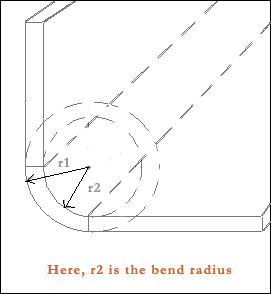
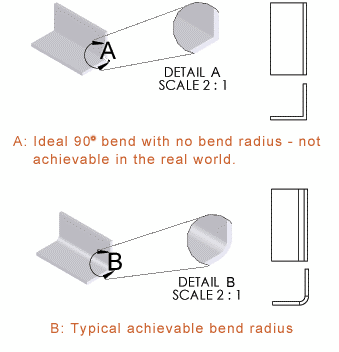
Sheet metal stretches during forming to some degree and the manufacturer must consider this when fabricating the enclosure. It is a function of tooling, metal thickness, bend radius, and metal composition. Metal composition varies somewhat with even the best quality metal from the best suppliers and as a result, there is always a certain tolerance on dimensions when bends are involved. Manufacturers will supply standard tolerances on request. Generally, cutouts should stay a minimum distance from bend radii in order to avoid deformation and wrinkling of the enclosure during forming, as shown below. Strictly speaking the cutout need only avoid being on the bend, but in practice, an exclusion zone of 1/16" is suggested to allow for manufacturing tolerances.
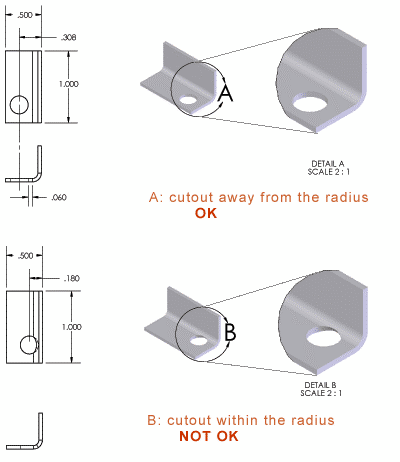
Special consideration must be given to the intersection of two bend lines, i.e., a corner of an enclosure. Specifically, extra material must be removed in order to prevent bends from interfering with each other and is called a corner relief. This is done automatically in Designer templates, but must be considered when designing enclosures from scratch.
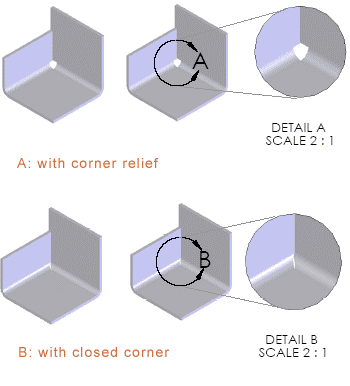
Self-clinching fasteners
Self-clinching fasteners are threaded nuts, studs, or standoffs that are mechanically pressed into sheet metal to provide solid fastening points. Nuts can be used to accept bolts, standoffs can be inserted for mounting circuit boards and studs can be used for mounting connectors. They are often referred to by the most common brand, PEM®, which is a trademark of Penn Engineering & Manufacturing Corp (http://www.pemnet.com). They are a very useful item and solve a lot of component mounting problems.
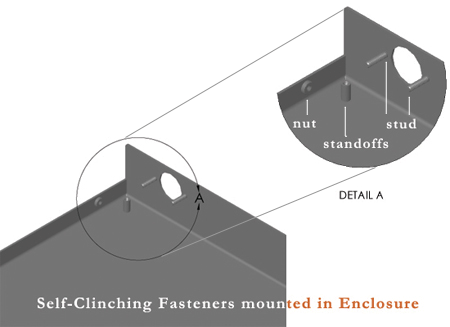
Protocase stocks a large assortment of self-clinching fasteners and installs them at a very reasonable cost.
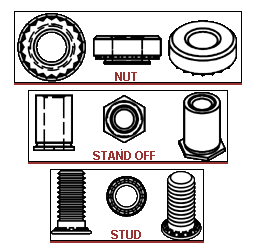
PEM Specifications
For part numbers with details such as thread size and incompatible materials, see:
- Self-clinching standoffs (Thru-Hole and Blind)
- Self-clinching nuts
- Self-clinching studs (Flush-Head and Concealed)
Welding
Depending on your particular application, spot-welded enclosures or fully seam-welded enclosures may be needed. With many enclosure designs, such as our standard U-shape (clamshell), no welding is required. One section of the enclosure contains small flanges with self-clinching nuts and the other section of the enclosure is fastened using mechanical fasteners such as machine screws or sheet metal screws. However, in some cases welded flanges are desired. Spot welding would be used in cases where disassembly is not required. Fully seam-welded edges may also be a requirement, especially if the application requires a more tightly sealed enclosure. Protocase offers both spot-welded and fully seam-welded enclosures.
Finishing
Powder coating
The standard finishing offered by Protocase is powder coating. This is now widely recognized as the industry standard for painting metal, providing a high quality, highly durable finish. Protocase offers a variety of standard stocked colors and textures. We can also provide fully custom colors for an additional fee based on the size and quantity of the parts.
To browse our stocked powder coat colors, see Stocked powder coat colors. When specifying a fully custom powder coat color, please provide us with the RAL number.
Silkscreening and digital printing
Protocase completes the task of manufacturing fully finished, quality enclosures by offering silkscreening or digital printing of labeling for connectors, switches, ports, etc., as well as graphics such as company and product logos. Both processes provide a very professional finish and excellent aesthetics, and can give your work that "wow" factor. For a detailed comparison along with accepted file formats for each method, please see [Silkscreen Vs. Direct Digital Printing].
If you are not using Protocase Designer to create and submit your design, you must provide graphics in digital format; faxed images will not provide sharp enough resolution for our process to replicate. If text-only screening is required, you can email or fax us the copy along with the font type, size, and color, and our Engineering & Design Services team will be happy to produce the required text-only screens. For more information, see Tell Me About Silkscreening and Digital Printing.
Adding custom cutouts
Protocase provides custom cutouts for connectors, displays, switches, ventilation, and so forth. There are very few limitations to the cutouts we can provide: if you can draw it, we can provide it. We can provide cutouts for your company logo and name, and we are creative with ventilation cutouts. You no longer have to settle for conventional, straight-line ventilation cutouts. Take a look at some of our samples.
Protocase support
Looking for further information? Don’t hesitate to email sales@protocase.com or call 1-866-849-3911 (toll free US & Canada). One of our technicians will be happy to answer your questions.